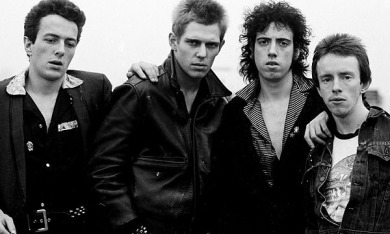
In May/June of 1981, The Clash were booked to play at the curiously named “Bond International Casino”—a discotheque that was previously a swanky supper club in the 1940s, and then a low-rent clothing store called Bonds until 1977 and they just kept the sign—in New York City in support of the sprawling three record set “Sandinista!” album. They were meant to play just eight gigs in the smallish Times Square space—capacity 1800 people—but the performances were dangerously oversold by the greedy promoters. Fire marshals and the NYC Building Department closed down both of the May 30th concerts, but the band vowed to honor each and every last ticket and so the number of shows was extended to seventeen, with matinee and evening performances added.
The Clash’s Bond Casino shows became an integral part of the rebel band’s legend and featured hand-picked opening acts like The Fall, Dead Kennedys, Lee “Scratch” Perry, Grandmaster Flash and the Furious Five, The Treacherous Three, KRAUT, Funkapolitan , The Slits, ESG, Bad Brains, The Bloods, The Sugarhill Gang, their pal from Texas Joe Ely and others. Many of the groups were openly booed by the rowdy crowds.
One of the shows, on June 9th, was professionally recorded for an FM radio broadcast and widely bootlegged. You can easily find it and every other of the Clash’s Bond shows—all of them were bootlegged—on audio blogs. But not a lot of footage has been seen from the Clash’s Bond residency. There were some tantalizing clips that were seen in Don Letts’ excellent Grammy-winning Westway To The World rock doc (released in 2000), as well as in the abandoned short “The Clash on Broadway” , but sadly the docs didn’t give you an entire song. However, Letts’ Bond footage was apparently shot on the same day as the FM recording was made and an enterprising Clash fan has restriped the stereo audio from that source and synced up some other angles found in various other places (mostly Letts’ docs). The results are probably the best glimpse we have at what went on at these shows.

Dozens of personal accounts of the shows can be found in several places, just Google it. One of the things that comes up is from a camera operator who claims that most, if not all of the Bonds shows were documented.
Don Letts and The Clash were to produce and shoot a documentary of Bonds and beyond that is the Clash on Broadway film featured at the end of Westway to the World. What started out as a one week shoot to get six songs live in the can became a year of our lives. The video for “This Is Radio Clash” was a lift from the 10 minute trailer for the unfinished film that we shot on 16mm and went all the way to a 35mm blowup to show potential distributors. Needless to say – the project was never completed as the band disassembled after Combat Rock. Clash on Broadway is the rough cut we had finished by the time to project was wrapped and went back to the UK.”
“We shot one complete show with multiple cameras and a 24 track mobile recorder. We also shot most of every show with one camera and in house 8 track recording. The band wore the same gear every night and Topper was such a consistent drummer – and the band well rehearsed – that we were able to build edits from different nights with no trouble at all.”
“Sadly – we never shot the opening acts. We started the gig with the intention of doing a six song DVD EP – not a full scale documentary. Shooting expanded as the story expanded and the shows stretched on.”
Additionally, over 50 reels of Letts’ NYC Clash footage, including their day as extras on the set of Martin Scorsese’s King of Comedy and a shitton of live Bond Casino footage was found in a South London basement in 2007 when Julien Temple was making his Joe Strummer doc and nearly ALL of it was in good shape. Hopefully we’ll see more from these shows in the future. Based on what you can see here, it must have been a blistering show !
First up, “Safe European Home.” I love how “the only band that matters” walk onstage like a street gang to the spaghetti-western sounds of Ennio Morricone’s “6 Seconds To Watch” (from the soundtrack to For A Few Dollars More). What band today could pull off swagger like that.



